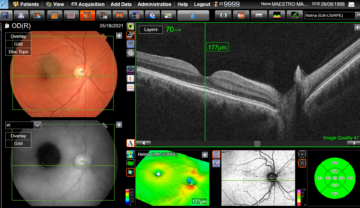
From Cold Start to Cashflow: Tips for Growing a New Practice
“That’s the branding I want: when patients say, ‘This doctor knows what he’s talking about.'”
It took Kevin Semma, OD, about a year to move from the idea of opening a new practice to actually opening the doors at Maple Eye Care and Eyewear in Bloomfield Hills, Michigan. He had been working as an associate in another practice for nearly five years, but as his confidence as a clinician and his understanding of the business and the patient experience grew, so did his frustrations. “I wanted to be the curator of decisions about how to spend the time with patients and what to offer them. I felt like I didn’t have enough quality time with my patients, and a change in approach and scheduling wasn’t something I could ask for,” he says. As it turned out, Dr. Semma found a location – and then just before he began to purchase equipment, he found Vision Source®. “Most doctors who are opening a new practice are worried about being able to afford brand new equipment. The conventional wisdom in that case is to be as lean as possible because there’s no revenue coming in,” he says. But he didn’t want a hodgepodge of antiques when he opened his doors. “Being a member of Vision Source meant that I could access phenomenal pricing on new, high-tech equipment,” he stated.
High-tech throughout
That was important to him because his business plan for Maple Eye Care and Eyewear was to offer a modern “high-design” optical. He did not feel like he could send patients into a boutique shopping experience if the exam that preceded it wasn’t incorporating advanced technology. So he decided to add the CV-5000S Digital Refraction System from Topcon, as well as the KR-1 Autorefractor, CL-300 Auto-Lensmeter, CA-800 Corneal Topographer, and a tower style slit lamp, the SL-D301. Four months later, at The Exchange® near Washington, D.C., he added the Maestro2 OCT and color fundus camera. “I was going for an Apple store kind of experience. To me, it’s important to blow people away with the experience. All the equipment is Bluetooth enabled and wireless, and I love to tell patients in the exam room, ‘All the data from the pre-test room is here now.’” Then as he performs the refraction while he’s seated at the desk some distance away, patients often remark how different the refraction experience is from previous visits to their eye doctors. Because the data collection is so easy and accurate, Dr. Semma has the chance to do what he has always wanted to do: talk with the patient. “When people have complaints or wonder about their eyes or vision, it’s my job to step in and explain it. But you don’t discover those issues until you have a conversation about how they use their lenses or when they have challenges,” he says. The Maestro OCT has added even more capabilities to his practice. The high-quality imaging and comprehensive reporting help his clinical data-gathering. “The wellness scan on the Maestro is extremely simple and acquires data of the optic nerve and macula as well as a color fundus photo. This helps me explain to patients what the back of their eye looks like,” he says. Taking that moment to point out what he sees in the images makes a strong impression on patients. “That’s the branding I want: when patients say, ‘This doctor knows what he’s talking about and took the time to explain it.’”
Where he wants to be
Approaching the fourth quarter of his first year in practice, “I’m right where I wanted to be. I’m seeing fewer patients per day than I was in the other practice, but my revenue per patient is higher – and that’s the quality of the exam, the education and the products. Showing the patient all the technology during the exam has a crossover effect,” he says. “It spills into the optical. Patients expect that we will offer them the best lenses and best frames. That experience in the exam room builds trust.” His capture rate is high as a result, too. “The whole experience has been one step above what they’re accustomed to, so they want to see what’s in the optical.” Dr. Semma encourages doctors who are starting cold or those who have older equipment in the exam lanes to upgrade. “Topcon has set up great pricing with Vision Source. The ROI is so worth it because patients notice those big and little differences – even something like a phoropter not having manual dials,” he says. Topcon sent Clinical Applications Specialists to help install equipment and train the team. Remote support has been invaluable. As Dr. Semma becomes more familiar with the technology, he can call and get a quick reminder of some feature he heard about earlier and is ready to explore. Having a high-tech office has not only made optometry more profitable, it has also made it more fun, he says. “It has rekindled my love for my career. I’ve been able to curate a space where I want to work and the daily work has become a much more enjoyable experience for me,” he says.
*Vision Source and Vision Source The Exchange are registered trademarks of Vision Source L.P.
MCA #4681




